Mind-blowing Poison Dart Frog Facts
Frogs are slimy creatures you see when you come out of the house on a rainy day. They usually cause no harm and will mind their own business. But like any other animal species, some are more harmful than you can imagine. One of the frog species like this is the poison dart frog. They are poisonous to the level where some can be fatal. Yes, a touch of their skin will leave you in pain for a couple of days.
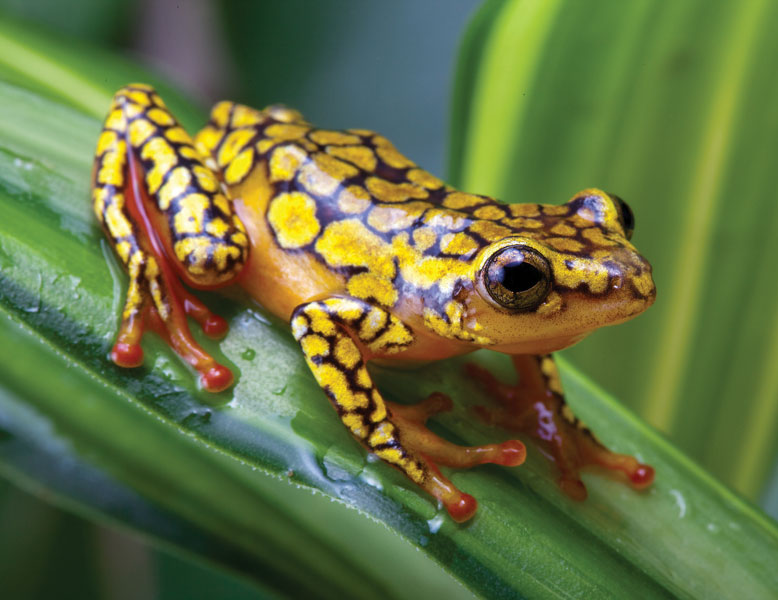
Scientific Name and Classification
Poison dart frog is the name for the group of frogs belonging to the family Dendrobatidae. Over 170 species with different scientific names for each frog species and genus. For example, the deadliest frog in the world is the golden poison frog, whose scientific name is Phyllobates Terribilis. The blue poison dart frog, which sports blue color, has the Latin name Dendrobates Tinctorius “Azureus.” The genus Phyllobates have the frogs with the highest levels of toxicity.
The poison dart frog belongs to the class Amphibia and the order Anura. (Amphibians are divided into three groups, and frogs, along with toads, come under Anura). In addition, these frogs come under the superfamily Dendrobatoidae.

Physical Characteristics (Appearance)
Frogs are small creatures, so most poison dart species are also small. Some can be smaller than 1.5cm in adult size, while the larger ones can be 6cm in adult form. Their weight is no more than 1 ounce on average.
Poison dart frogs stand out because of their bright skin colors. Unlike other frogs whose base colors are either shades of dark greens or browns, you can find a lot of color combinations on poison dart frogs. Blue, yellow, red, golden, green, black are the colors most frogs are in. Yet, there are species in poison darts in shades of brown and tan. The ones in dull colors are not that toxic to other animals.
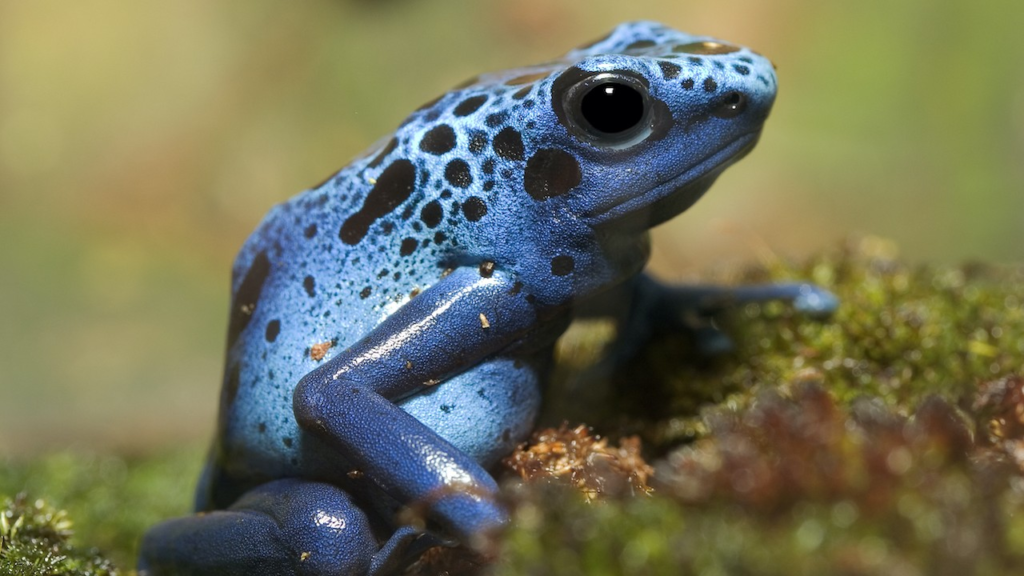
The brightly colored frogs are considered to be aposematic organisms. Aposematism is characterized by advertising an animal to predators that it will not be worth it to attack them. Their colors defend against other animals as unappetizing food for poison darts. The frog species have gone through aposematic colorations at least four times.
Other than their skin color, the rest of the features are similar to other frog species. Their skin is smooth and absorbent. However, it has a moist layer on the skin, making it look damp. Their toes are webbed too.
Behavior
These frogs are diurnal. This means that they are very active during the day and sleep during the night. There is a period of inactivity after the sun goes down. They sit in the sun to absorb the sunlight, making them more active. Poison dart frogs are usually black and white with various bright colors, absorbing the sunlight faster.
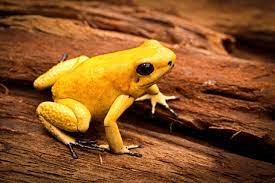
Different frogs species have different social behaviors. Some species are very social and peaceful and allow others to live in their territories. On the other hand, some species become very aggressive and attack strangers who come into their environment.
Communication is done through vocals. You see this in animals that jump and fly because they find it challenging to communicate through scents. For example, poison dart frogs use sounds such as croaking and squeaking for various functions. For example, it could attract a mate, signal distress, or even advertise territories.
Range and Habitat
Poison dart frogs thrive in humid and tropical environments. They are native to damp tropical rainforests of Central and South America. They are also found in Bolivia, Peru, Brazil, Columbia, Ecuador, etc. They can also be present in Hawai. They used to be imported and smuggled as part of the pet trade to Europe and the US, but this has considerably slowed down. These frogs are susceptible animals who do not sit well in polluted areas. They can often be confused with other frog species called Mantella. The difference is the population of Mantellas is limited to Madagascar only.
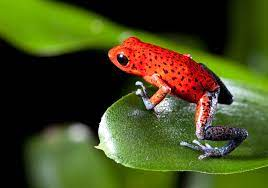
These frogs prefer to live in trees close to the ground or the leaves clutter on the floor. However, they tend to live on tree branches too that are as much as 10m above ground.
Reproduction
Both males and females are very active during the mating period, which aligns around the rainfall period. Males look for perches to communicate, and females look for nesting areas. The females get so competitive they devour the eggs of other frogs during this time.
The male frogs court the females through wrestling, stroking, and leading them around. This can take a couple of hours until the female agrees to mate and lays the eggs. The female lays an average of 10 eggs on the floor, hidden under the leaves litter, after which the male fertilizes it. Then, both the parents take turns to protect the eggs.
The baby frogs are called tadpoles. They are born 10-18 days after fertilization happens. The parents carry the tadpoles on their backs to pools of water where they grow and mature. The tadpoles eat the invertebrates in the water. The mother also supplies the tadpoles with eggs to enhance their diets.
Diet
The poison dart frog’s diet consists of insects found on the ground. They capture their prey using their long retractable tongue. The frogs are believed to be poisonous because of their diet. However, the ones raised in captivity are not poisonous because they are fed crickets and fruit flies which are not toxic.
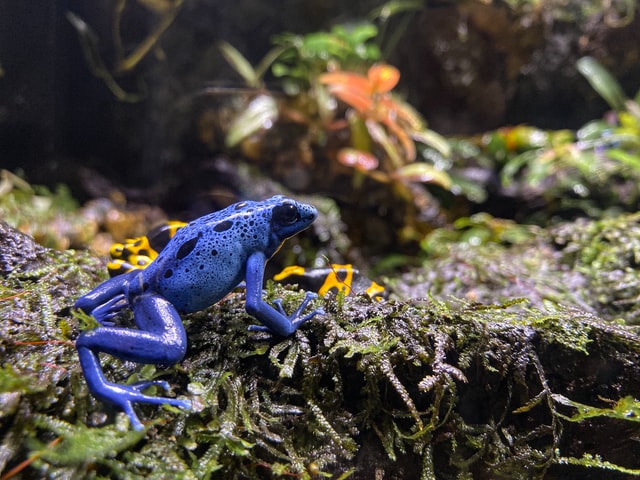
They eat ants, termites, flies, and certain poisonous insects. The insects are likely to gain the poison from the plant diet. Tadpoles eat algae and unfertilized eggs given by the mother. Some species are cannibals and eat tadpoles of other frog species.
Poison Dart Frog Toxicity
The skin of poison dart frogs has alkaloids that are used as a chemical defense against predators. There are 28 structures of alkaloids present in the poison frogs. The poison is not a result of evolution instead of a diet. The chemicals are sequestered from arthropods that are the frog’s prey. Some studies prove that the mothers feed unfertilized eggs that have small amounts of the alkaloids to the tadpoles. This would develop the poison level when the tadpoles grow and mature.
The skin and toxicity of the frogs also keep changing because females are the choosers for males during mating. Females tend to choose more brightly colored males, leading to males evolving their colors over time.
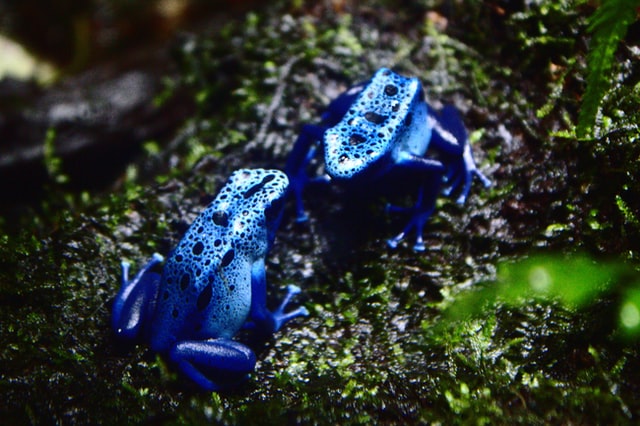
The poison darts are of great medicinal value as well. For example, the venom of the Phantasmal poison arrow frog has been used to make painkillers. In addition, the secretions have been used as muscle relaxants, heart stimulants, and appetite suppressants.
Conservation Status
These frogs have a declining population. Some species are listed as endangered, and some as critically endangered. It is due to habitat loss and fungal diseases. Unfortunately, it is hard to get a proper estimate because they live in remote areas.
FAQs
Can poison dart frogs kill you?
A touch of the frog will only irritate the skin. The frog’s name comes from the times when natives used to smear the frog’s poison on the tip of the dart. It would be fatal if the poison entered the body through a wound or is ingested. The toxicity of the golden poison frog is so powerful that it can kill 10-20 humans or ten thousand mice.
What happens if you touch a poison dart frog?
The skin of the poison dart frog is the poisonous part. So if you touch it, there will be irritation of the skin with muscle paralysis, nausea, and swelling. But if you feel one kept in captivity, nothing will happen because the frogs are free of toxicity there.
Does anything eat poison dart frogs?
Poison darts would seem like they are free of predators, but animals are immune to the skin’s poison. For example, the snake, Leimadophis Epinephelus, is a great danger to the frogs.
Can you have a poison dart frog as a pet?
Yes! The poison of the frogs comes from the diet. So if you change the diet, the frog will lose toxicity if caught in the wild.
Conclusion
So, that is it to know about the poison dart frogs. They are very interesting, one-of-a-kind creatures in the world. So the next time you go searching for frogs and come across a very bright colored one, remember the facts you have learned here and probably just stare at it from a distance.
